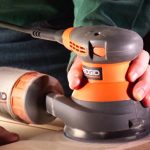We may receive a commission when you use our affiliate links. However, this does not impact our recommendations.

For many years I was happy with my Olson coping saw, which I bought from the now-vanished Aufdenkamp Hardware in 1996. The saw locked tight. It held the blade without rotating. And when armed with Olson-brand blades, the thing cut smoothly and quickly.
A few years ago, the saw began to tick me off. I couldn’t get it tight enough (even after stretching the frame). The blade holders would rotate in the middle of the cut. It was as bad as my junky Craftsman coping saw from elementary school, which has never worked.
I switched to fretsaws for a while, but I snapped a lot of blades (more on fretsaws coming soon).
This week I took a close look at my Olson, plus a second new old stock Olson that woodworker Carl Bilderback had given me. It was considerably older than mine and seemed to hold blades better than mine. Why did mine stink so bad? I took the saws apart to investigate.
It was the wave washers. The Olson saws come equipped with two wave washers , wavy discs of metal , that help the saw keep its setting when you apply tension. The wave washers on my saw were now lake washers (meaning they were completely flat). So they weren’t doing Jack buddy to tighten up the blade mechanism.
So it was off to Home Depot to pick up some different washers. I tried some 5/16″ toothed washers, but those things did as much as the flattened washers. Then I tried the traditional split lock washer. That did the trick. I put one lock washer between the handle and the frame, and a second lock washer between the frame and the blade holder at the toe.
Now it is better than new. And souping up both saws was about 50 cents.
If you have an Olson saw, this is a great little upgrade. And if you don’t have an Olson saw or blades, you can remedy that at ToolsForWorkingWood.com.
– Christopher Schwarz
Other Coping Saw Resources to Investigate
– Read about the history of the coping saw and its relation to fretsaws and Morris saws in this blog post.
– Buy a Olson coping saw and blades from ToolsforWorkingWood.com.
– Read the book “Coping Saw Work” free on GoogleBooks.com.

Here are some supplies and tools we find essential in our everyday work around the shop. We may receive a commission from sales referred by our links; however, we have carefully selected these products for their usefulness and quality.








Christopher: What I would like is an artilce on the correct technique for using the coping saw. I can’t make the darn thing work well; I use Olsen blades and a sturdy frame that looks just like the Olsen. I would buy a new Olsen but I believe its my technique that is at fault. Can you print an artilce on how to use a coping saw, like articles I have seen about how to use a dovetail saw? Thanks
Tom Russell
J’ever try a jeweler’s saw? They look like a coping saw but they use blades without pins, and the blade can’t be turned in the frame. But those blades. They come in sizes down to half the width of a nat’s @$$. Well, really small. And they cut metal metal very well. They even make a blade that’s twisted for freehand cutting pattern wax; cuts in any direction.
This is weird. I was going to email you about this trick recently, but forgot. I got frustrated with the coping saw after first buying one over a year ago. I just added a washer to the one end that didn’t have one. Works great.
I got one of those Stanley Fat Max saws you wrote about a while back and I like it a lot.
Guess I’ll treat myself to an Olson as well.
There’s always a little extra room in the saw safe.
Thanks Chris.
I have a Craftsman coping saw that I bought over ten years ago. It is identical to an Olsen coping saw in everyway but the name stamped on it. I started to have the same problem with it last year and "fixed" it the same way when I couldn’t find a quick source for the wave washers. Apparently I missed an opportunity to win "Tricks of the Trade" by not submitting this idea then.
Just received the August issue of Popular Woodworking Magazine. I really need to do something about my bench envy. The new Roubo is a killer. The legs look like some type of poplar to me.